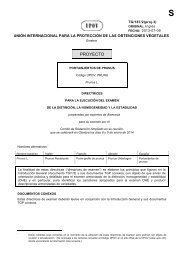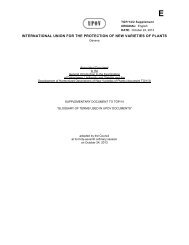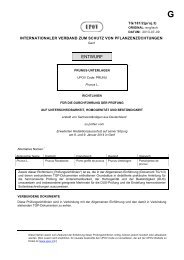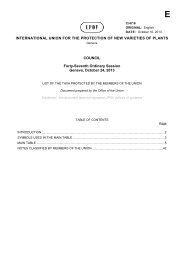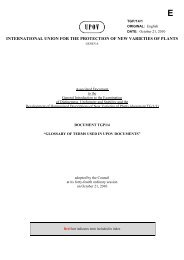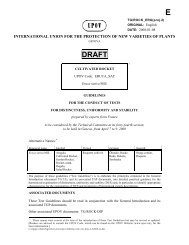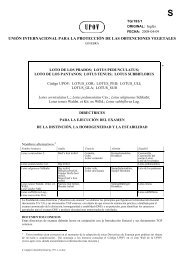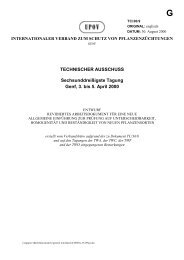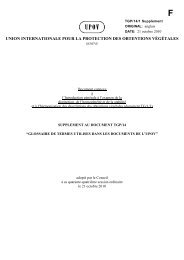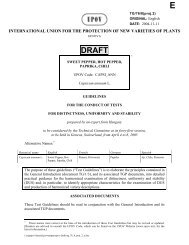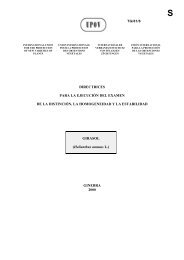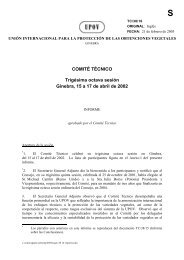draft - International Union for the Protection of New Varieties of Plants
draft - International Union for the Protection of New Varieties of Plants
draft - International Union for the Protection of New Varieties of Plants
You also want an ePaper? Increase the reach of your titles
YUMPU automatically turns print PDFs into web optimized ePapers that Google loves.
n:\orgupov\shared\tg\peach_cd\upov_<strong>draft</strong>s\tg_53_6_rev_proj_3xxx.doc<br />
TG/53/6 Rev.(proj.3)<br />
ORIGINAL: English<br />
DATE: 2008-05-26<br />
INTERNATIONAL UNION FOR THE PROTECTION OF NEW VARIETIES OF PLANTS<br />
GENEVA<br />
DRAFT<br />
PEACH<br />
UPOV Code: PRUNU_PER<br />
Prunus persica (L.) Batsch<br />
GUIDELINES<br />
FOR THE CONDUCT OF TESTS<br />
FOR DISTINCTNESS, UNIFORMITY AND STABILITY<br />
prepared by an expert from France<br />
to be considered by <strong>the</strong><br />
Technical Working Party <strong>for</strong> Fruit Crops<br />
at its thirty-ninth session, to be held in Lisbon, Portugal, from June 2 to 6, 2008<br />
Alternative Names: *<br />
Botanical name English French German Spanish<br />
Prunus persica (L.) Batsch,<br />
Persica vulgaris Mill.,<br />
Prunus L. subg. Persica,<br />
Peach Pêcher Pfirsich, Duraznero,<br />
Durazno,<br />
Melocotonero<br />
The purpose <strong>of</strong> <strong>the</strong>se guidelines (“Test Guidelines”) is to elaborate <strong>the</strong> principles contained in<br />
<strong>the</strong> General Introduction (document TG/1/3), and its associated TGP documents, into detailed<br />
practical guidance <strong>for</strong> <strong>the</strong> harmonized examination <strong>of</strong> distinctness, uni<strong>for</strong>mity and stability<br />
(DUS) and, in particular, to identify appropriate characteristics <strong>for</strong> <strong>the</strong> examination <strong>of</strong> DUS<br />
and production <strong>of</strong> harmonized variety descriptions.<br />
ASSOCIATED DOCUMENTS<br />
These Test Guidelines should be read in conjunction with <strong>the</strong> General Introduction, its<br />
associated TGP documents and <strong>the</strong> Test Guidelines <strong>for</strong> Prunus Rootstocks, document<br />
TG/187/1<br />
* These names were correct at <strong>the</strong> time <strong>of</strong> <strong>the</strong> introduction <strong>of</strong> <strong>the</strong>se Test Guidelines but may be revised or updated.<br />
[Readers are advised to consult <strong>the</strong> UPOV Code, which can be found on <strong>the</strong> UPOV Website (www.upov.int), <strong>for</strong> <strong>the</strong><br />
latest in<strong>for</strong>mation.]<br />
*<br />
E
TG/53/6/Rev.(proj.3)<br />
Peach, 2008-05-26<br />
page 2<br />
TABLE OF CONTENTS PAGE<br />
1. SUBJECT OF THESE TEST GUIDELINES..................................................................................................3<br />
2. MATERIAL REQUIRED ...............................................................................................................................3<br />
3. METHOD OF EXAMINATION.....................................................................................................................3<br />
3.1 Number <strong>of</strong> Growing Cycles ....................................................................................................................3<br />
3.2 Testing Place...........................................................................................................................................3<br />
3.3 Conditions <strong>for</strong> Conducting <strong>the</strong> Examination...........................................................................................3<br />
3.4 Test Design .............................................................................................................................................4<br />
3.5 Number <strong>of</strong> <strong>Plants</strong> / Parts <strong>of</strong> <strong>Plants</strong> to be Examined.................................................................................4<br />
3.6 Additional Tests ......................................................................................................................................4<br />
4. ASSESSMENT OF DISTINCTNESS, UNIFORMITY AND STABILITY...................................................4<br />
4.1 Distinctness .............................................................................................................................................4<br />
4.2 Uni<strong>for</strong>mity...............................................................................................................................................5<br />
4.3 Stability ...................................................................................................................................................5<br />
5. GROUPING OF VARIETIES AND ORGANIZATION OF THE GROWING TRIAL.................................5<br />
6. INTRODUCTION TO THE TABLE OF CHARACTERISTICS...................................................................6<br />
6.1 Categories <strong>of</strong> Characteristics...................................................................................................................6<br />
6.2 States <strong>of</strong> Expression and Corresponding Notes.......................................................................................6<br />
6.3 Types <strong>of</strong> Expression................................................................................................................................6<br />
6.4 Example <strong>Varieties</strong> ...................................................................................................................................6<br />
6.5 Legend.....................................................................................................................................................6<br />
7. TABLE OF CHARACTERISTICS/TABLEAU DES<br />
CARACTÈRES/MERKMALSTABELLE/TABLA DE CARACTERES.......................................................7<br />
8. EXPLANATIONS ON THE TABLE OF CHARACTERISTICS ................................................................30<br />
8.1 Explanations covering several characteristics.......................................................................................30<br />
8.2 Explanations <strong>for</strong> individual characteristics ...........................................................................................30<br />
9. LITERATURE ..............................................................................................................................................36<br />
10 TECHNICAL QUESTIONNAIRE ...............................................................................................................38
1. Subject <strong>of</strong> <strong>the</strong>se Test Guidelines<br />
TG/53/6/Rev.(proj.3)<br />
Peach, 2008-05-26<br />
page 3<br />
These Test Guidelines apply to all varieties <strong>of</strong> peach (including nectarine) <strong>of</strong> <strong>the</strong><br />
species Prunus persica (L.) Batsch.<br />
2. Material Required<br />
2.1 The competent authorities decide on <strong>the</strong> quantity and quality <strong>of</strong> <strong>the</strong> plant material<br />
required <strong>for</strong> testing <strong>the</strong> variety and when and where it is to be delivered. Applicants<br />
submitting material from a State o<strong>the</strong>r than that in which <strong>the</strong> testing takes place must ensure<br />
that all customs <strong>for</strong>malities and phytosanitary requirements are complied with.<br />
2.2 The material is to be supplied in <strong>the</strong> <strong>for</strong>m <strong>of</strong> budsticks, dormant shoots <strong>for</strong> grafting,<br />
[France 2008: or standard grafted trees, with dormant buds or not,], grafted on appropriate<br />
peach rootstock to be selected by <strong>the</strong> competent authorities.<br />
Fr 08: France mind you on <strong>the</strong> risk to adopt budsticks furniture (<strong>of</strong>f types buds…)<br />
2.3 The minimum quantity <strong>of</strong> plant material, to be supplied by <strong>the</strong> applicant, should be:<br />
– 5 budsticks with sufficient buds to propagate 5 trees (to be sent at budding time);<br />
– 5 dormant shoots <strong>for</strong> grafting, sufficient to propagate 5 trees (to be sent at<br />
grafting time); [France 2008: this furniture point is not to be understood as it is<br />
written] or<br />
– 5 trees grafted, Fr 08: with dormant buds or not, on appropriate peach rootstock<br />
to be selected by <strong>the</strong> competent authorities<br />
2.4 The plant material supplied should be visibly healthy, not lacking in vigor, nor<br />
affected by any important pest or disease.<br />
2.5 The plant material should not have undergone any treatment which would affect <strong>the</strong><br />
expression <strong>of</strong> <strong>the</strong> characteristics <strong>of</strong> <strong>the</strong> variety, unless <strong>the</strong> competent authorities allow or<br />
request such treatment. If it has been treated, full details <strong>of</strong> <strong>the</strong> treatment must be given.<br />
3. Method <strong>of</strong> Examination<br />
3.1 Number <strong>of</strong> Growing Cycles<br />
The minimum duration <strong>of</strong> tests should normally be two independent growing cycles.<br />
3.2 Testing Place<br />
Tests are normally conducted at one place. In <strong>the</strong> case <strong>of</strong> tests conducted at more than<br />
one place, guidance is provided in TGP/9 “Examining Distinctness”.<br />
3.3 Conditions <strong>for</strong> Conducting <strong>the</strong> Examination<br />
3.3.1 The tests should be carried out under conditions ensuring satisfactory growth <strong>for</strong> <strong>the</strong><br />
expression <strong>of</strong> <strong>the</strong> relevant characteristics <strong>of</strong> <strong>the</strong> variety and <strong>for</strong> <strong>the</strong> conduct <strong>of</strong> <strong>the</strong><br />
examination.
TG/53/6/Rev.(proj.3)<br />
Peach, 2008-05-26<br />
page 4<br />
3.3.2 In particular, it is essential that <strong>the</strong> [trees] / [plants] produce a satisfactory crop <strong>of</strong> fruit<br />
in each <strong>of</strong> <strong>the</strong> two growing cycles.<br />
3.3.3 Because daylight varies, color determinations made against a color chart should be<br />
made ei<strong>the</strong>r in a suitable cabinet providing artificial daylight or in <strong>the</strong> middle <strong>of</strong> <strong>the</strong> day in a<br />
room without direct sunlight. The spectral distribution <strong>of</strong> <strong>the</strong> illuminant <strong>for</strong> artificial daylight<br />
should con<strong>for</strong>m with <strong>the</strong> CIE Standard <strong>of</strong> Preferred Daylight D 6500 and should fall within<br />
<strong>the</strong> tolerances set out in <strong>the</strong> British Standard 950, Part I. These determinations should be<br />
made with <strong>the</strong> plant part placed against a white background.<br />
3.4 Test Design<br />
3.4.1 Each test should be designed to result in a total <strong>of</strong> at least 5 trees, as a minimum.<br />
3.4.2 The design <strong>of</strong> <strong>the</strong> tests should be such that plants or parts <strong>of</strong> plants may be removed<br />
<strong>for</strong> measurement or counting without prejudice to <strong>the</strong> observations which must be made up to<br />
<strong>the</strong> end <strong>of</strong> <strong>the</strong> growing cycle.<br />
3.5 Number <strong>of</strong> <strong>Plants</strong> / Parts <strong>of</strong> <strong>Plants</strong> to be Examined<br />
Unless o<strong>the</strong>rwise indicated, all observations should be made on 5 plants or parts taken<br />
from each <strong>of</strong> 5 plants. In <strong>the</strong> case <strong>of</strong> parts <strong>of</strong> plants, <strong>the</strong> number to be taken from each <strong>of</strong> <strong>the</strong><br />
plants should be 5.<br />
3.6 Additional Tests<br />
Additional tests, <strong>for</strong> examining relevant characteristics, may be established.<br />
4. Assessment <strong>of</strong> Distinctness, Uni<strong>for</strong>mity and Stability<br />
4.1 Distinctness<br />
4.1.1 General Recommendations<br />
It is <strong>of</strong> particular importance <strong>for</strong> users <strong>of</strong> <strong>the</strong>se Test Guidelines to consult <strong>the</strong> General<br />
Introduction prior to making decisions regarding distinctness. However, <strong>the</strong> following points<br />
are provided <strong>for</strong> elaboration or emphasis in <strong>the</strong>se Test Guidelines.<br />
4.1.2 Consistent Differences<br />
The differences observed between varieties may be so clear that more than one<br />
growing cycle is not necessary. In addition, in some circumstances, <strong>the</strong> influence <strong>of</strong> <strong>the</strong><br />
environment is not such that more than a single growing cycle is required to provide<br />
assurance that <strong>the</strong> differences observed between varieties are sufficiently consistent. One<br />
means <strong>of</strong> ensuring that a difference in a characteristic, observed in a growing trial, is<br />
sufficiently consistent is to examine <strong>the</strong> characteristic in at least two independent growing<br />
cycles.
4.1.3 Clear Differences<br />
TG/53/6/Rev.(proj.3)<br />
Peach, 2008-05-26<br />
page 5<br />
Determining whe<strong>the</strong>r a difference between two varieties is clear depends on many<br />
factors, and should consider, in particular, <strong>the</strong> type <strong>of</strong> expression <strong>of</strong> <strong>the</strong> characteristic being<br />
examined, i.e. whe<strong>the</strong>r it is expressed in a qualitative, quantitative, or pseudo-qualitative<br />
manner. There<strong>for</strong>e, it is important that users <strong>of</strong> <strong>the</strong>se Test Guidelines are familiar with <strong>the</strong><br />
recommendations contained in <strong>the</strong> General Introduction prior to making decisions regarding<br />
distinctness.<br />
4.2 Uni<strong>for</strong>mity<br />
4.2.1 It is <strong>of</strong> particular importance <strong>for</strong> users <strong>of</strong> <strong>the</strong>se Test Guidelines to consult <strong>the</strong> General<br />
Introduction prior to making decisions regarding uni<strong>for</strong>mity. However, <strong>the</strong> following points<br />
are provided <strong>for</strong> elaboration or emphasis in <strong>the</strong>se Test Guidelines:<br />
4.2.2 For <strong>the</strong> assessment <strong>of</strong> uni<strong>for</strong>mity, a population standard <strong>of</strong> 1% and an acceptance<br />
probability <strong>of</strong> at least 95% should be applied. In <strong>the</strong> case <strong>of</strong> a sample size <strong>of</strong> 5 plants,<br />
no <strong>of</strong>f-types are allowed.<br />
4.3 Stability<br />
4.3.1 In practice, it is not usual to per<strong>for</strong>m tests <strong>of</strong> stability that produce results as certain as<br />
those <strong>of</strong> <strong>the</strong> testing <strong>of</strong> distinctness and uni<strong>for</strong>mity. However, experience has demonstrated<br />
that, <strong>for</strong> many types <strong>of</strong> variety, when a variety has been shown to be uni<strong>for</strong>m, it can also be<br />
considered to be stable.<br />
4.3.2 Where appropriate, or in cases <strong>of</strong> doubt, stability may be tested, ei<strong>the</strong>r by growing a<br />
fur<strong>the</strong>r generation, or by testing a new plant stock to ensure that it exhibits <strong>the</strong> same<br />
characteristics as those shown by <strong>the</strong> previous material supplied.<br />
5. Grouping <strong>of</strong> <strong>Varieties</strong> and Organization <strong>of</strong> <strong>the</strong> Growing Trial<br />
5.1 The selection <strong>of</strong> varieties <strong>of</strong> common knowledge to be grown in <strong>the</strong> trial with <strong>the</strong><br />
candidate varieties and <strong>the</strong> way in which <strong>the</strong>se varieties are divided into groups to facilitate<br />
<strong>the</strong> assessment <strong>of</strong> distinctness are aided by <strong>the</strong> use <strong>of</strong> grouping characteristics.<br />
5.2 Grouping characteristics are those in which <strong>the</strong> documented states <strong>of</strong> expression, even<br />
where produced at different locations, can be used, ei<strong>the</strong>r individually or in combination with<br />
o<strong>the</strong>r such characteristics: (a) to select varieties <strong>of</strong> common knowledge that can be excluded<br />
from <strong>the</strong> growing trial used <strong>for</strong> examination <strong>of</strong> distinctness; and (b) to organize <strong>the</strong> growing<br />
trial so that similar varieties are grouped toge<strong>the</strong>r.<br />
5.3 The following have been agreed as useful grouping characteristics:<br />
(a) Tree: size (characteristic 1)<br />
(b) Flower: type (characteristic 8)<br />
(c) Petiole: nectaries (characteristic 28)<br />
(d) Fruit: pubescence (characteristic 48)<br />
(e) Fruit: main color <strong>of</strong> flesh (characteristic 55)<br />
(f) Stone: adherence to flesh (characteristic 68)<br />
(g) Time <strong>of</strong> beginning <strong>of</strong> flowering (characteristic 76)<br />
(h) Time <strong>of</strong> maturity <strong>for</strong> consumption (characteristic 78)
TG/53/6/Rev.(proj.3)<br />
Peach, 2008-05-26<br />
page 6<br />
5.4 Guidance <strong>for</strong> <strong>the</strong> use <strong>of</strong> grouping characteristics, in <strong>the</strong> process <strong>of</strong> examining<br />
distinctness, is provided through <strong>the</strong> General Introduction.<br />
6. Introduction to <strong>the</strong> Table <strong>of</strong> Characteristics<br />
6.1 Categories <strong>of</strong> Characteristics<br />
6.1.1 Standard Test Guidelines Characteristics<br />
Standard Test Guidelines characteristics are those which are approved by UPOV <strong>for</strong><br />
examination <strong>of</strong> DUS and from which members <strong>of</strong> <strong>the</strong> <strong>Union</strong> can select those suitable <strong>for</strong> <strong>the</strong>ir<br />
particular circumstances.<br />
6.1.2 Asterisked Characteristics<br />
Asterisked characteristics (denoted by *) are those included in <strong>the</strong> Test Guidelines<br />
which are important <strong>for</strong> <strong>the</strong> international harmonization <strong>of</strong> variety descriptions and should<br />
always be examined <strong>for</strong> DUS and included in <strong>the</strong> variety description by all members <strong>of</strong> <strong>the</strong><br />
<strong>Union</strong>, except when <strong>the</strong> state <strong>of</strong> expression <strong>of</strong> a preceding characteristic or regional<br />
environmental conditions render this inappropriate.<br />
6.2 States <strong>of</strong> Expression and Corresponding Notes<br />
States <strong>of</strong> expression are given <strong>for</strong> each characteristic to define <strong>the</strong> characteristic and to<br />
harmonize descriptions. Each state <strong>of</strong> expression is allocated a corresponding numerical note<br />
<strong>for</strong> ease <strong>of</strong> recording <strong>of</strong> data and <strong>for</strong> <strong>the</strong> production and exchange <strong>of</strong> <strong>the</strong> description.<br />
6.3 Types <strong>of</strong> Expression<br />
An explanation <strong>of</strong> <strong>the</strong> types <strong>of</strong> expression <strong>of</strong> characteristics (qualitative, quantitative<br />
and pseudo-qualitative) is provided in <strong>the</strong> General Introduction.<br />
6.4 Example <strong>Varieties</strong><br />
Where appropriate, example varieties are provided to clarify <strong>the</strong> states <strong>of</strong> expression <strong>of</strong><br />
each characteristic.<br />
6.5 Legend<br />
(*) Asterisked characteristic – see Chapter 6.1.2<br />
QL: Qualitative characteristic – see Chapter 6.3<br />
QN: Quantitative characteristic – see Chapter 6.3<br />
PQ: Pseudo-qualitative characteristic – see Chapter 6.3<br />
(a)-(f) See Explanations on <strong>the</strong> Table <strong>of</strong> Characteristics in Chapter 8.1<br />
(+) See Explanations on <strong>the</strong> Table <strong>of</strong> Characteristics in Chapter 8.2
1.<br />
(*)<br />
TG/53/6/Rev.(proj.3)<br />
Peach, 2008-05-26<br />
page 7<br />
7. Table <strong>of</strong> Characteristics/Tableau des caractères/Merkmalstabelle/Tabla de caracteres<br />
English<br />
Tree: size<br />
(Fr 08: in winter)<br />
français<br />
Arbre: taille<br />
(Fr 08 : en hiver)<br />
deutsch<br />
Baum: Größe<br />
español<br />
Example <strong>Varieties</strong>/<br />
Exemples/<br />
Beispielssorten/<br />
Variedades ejemplos<br />
QN very small très petit sehr klein Bonanza 1<br />
2.<br />
(+)<br />
small petit klein Richaven 3<br />
medium moyen mittel Robin 5<br />
large grand groß Redhaven 7<br />
very large très grand sehr groß Champion 9<br />
Tree: vigor<br />
(Fr 08: during<br />
growing period)<br />
Arbre: vigueur<br />
(Fr 08: en<br />
végétation)<br />
Baum: Wuchsstärke<br />
QN weak faible gering J. H. Hale 3<br />
3.<br />
(*)<br />
(+)<br />
medium moyenne mittel Robin 5<br />
strong <strong>for</strong>te stark Springtime 7<br />
Tree: habit<br />
(Fr 08: in winter)<br />
Arbre: port Baum: Wuchs<strong>for</strong>m<br />
QN upright dressé aufrecht Nectarose, Pillar 1<br />
4.<br />
(+)<br />
upright to spreading Fairhaven, Redwing 2<br />
spreading étalé breitwüchsig Elegant Lady,<br />
O’Henry Albertina<br />
drooping retombant überhängend Cocont Ice,<br />
Scarlet O’Hara<br />
weeping très retombant lang überhängend Biancopendulo 5<br />
Flowering shoot:<br />
thickness<br />
(Fr 08: in winter)<br />
Rameau mixte:<br />
grosseur<br />
Blütentrieb: Dicke<br />
QN thin fin dünn Mayred 3<br />
medium moyen mittel Redhaven 5<br />
thick gros dick Lizzie, Flavorcrest 7<br />
2007 - 4a to check if characteristic “tendency to produce on brindilles”is necessary. France: not necessary, can be added in <strong>the</strong><br />
observations if needed. TWF 2007: Answer to be not introduced – France 08: keep it<br />
Note/<br />
Nota<br />
3<br />
4
English<br />
5. Flowering shoot:<br />
length <strong>of</strong> internodes<br />
(as <strong>for</strong> 4)<br />
français<br />
Rameau mixte:<br />
longueur des<br />
entrenœuds (comme<br />
pour 4)<br />
TG/53/6/Rev.(proj.3)<br />
Peach, 2008-05-26<br />
page 8<br />
deutsch<br />
Blütentrieb: Länge<br />
der Internodien (wie<br />
unter 4)<br />
español<br />
Example <strong>Varieties</strong>/<br />
Exemples/<br />
Beispielssorten/<br />
Variedades ejemplos<br />
QN very short très courts sehr kurz Bonanza 1<br />
6.<br />
(*)<br />
short courts kurz June Gold,<br />
Merrill Sundance<br />
medium moyens mittel Redhaven 5<br />
long longs lang Fairhaven 7<br />
very long très longs sehr lang 9<br />
DELETED in 2007<br />
and combined with<br />
<strong>the</strong> <strong>New</strong> 6 below<br />
Flowering shoot:<br />
anthocyanin<br />
coloration<br />
Rameau mixte: Wahrer<br />
pigmentation Fruchttrieb:<br />
anthocyanique Anthocyanfärbung<br />
(comme pour 4, coté (wie unter 4, nicht<br />
ensoleillé exclu) auf der Sonnenseite)<br />
? absent absente fehlend De flor doble blanca 1<br />
6.<br />
(*)<br />
present présente vorhanden Springtime 9<br />
Flowering shoot:<br />
intensity <strong>of</strong><br />
anthocyanin<br />
coloration (shaded<br />
side)<br />
Rameau mixte:<br />
intensité de la<br />
pigmentation<br />
anthocyanique (sur<br />
la face à l’ombre)<br />
Wahrer<br />
Fruchttrieb: Dichte<br />
der Blütenknospen<br />
(……………..)<br />
(Fr 08: would like to<br />
have absent (1) and<br />
very weak (3)….<br />
? absent or very weak absent ou très faible De flor doble blanca 1<br />
weak faible gering Springtime 3<br />
medium moyenne mittel Fuzalode 5<br />
strong <strong>for</strong>te stark Robin,<br />
Sanguine Chanas<br />
Note/<br />
Nota<br />
3<br />
7
English<br />
français<br />
TG/53/6/Rev.(proj.3)<br />
Peach, 2008-05-26<br />
page 9<br />
deutsch<br />
español<br />
Example <strong>Varieties</strong>/<br />
Exemples/<br />
Beispielssorten/<br />
Variedades ejemplos<br />
Remarks from NZ and Brazil <strong>for</strong> <strong>the</strong> low variability in <strong>the</strong>ir material <strong>for</strong> this characteristic, but not in <strong>the</strong> European one (pascal) Datas<br />
inserted <strong>for</strong> in<strong>for</strong>mation <strong>for</strong> <strong>the</strong> <strong>draft</strong>ers : TWF 2007 T.Pascal arguments accepted<br />
7.<br />
(+)<br />
Flowering shoot:<br />
density <strong>of</strong> flower<br />
buds (as <strong>for</strong> 4)<br />
Rameau mixte:<br />
densité des boutons<br />
floraux (comme<br />
pour 4)<br />
QN very sparse très peu dense < 10<br />
fleurs/m<br />
sparse peu dense 10 a 20<br />
fleurs/m<br />
medium moyenne 20 a 30<br />
fleurs/m<br />
dense dense 30 a 40<br />
fleurs/m<br />
very dense très dense >40<br />
fleurs/m<br />
Wahrer<br />
Fruchttrieb:<br />
vorwiegende<br />
Anordnung der<br />
Blütenknospen (wie<br />
unter 4)<br />
NZ proposes to delete (France can accept <strong>the</strong> deletion) : TWF 2007 : deleted<br />
9. - Flowering shoot:<br />
general distribution<br />
<strong>of</strong> flower buds (as<br />
<strong>for</strong> 4)<br />
Rameau mixte:<br />
répartition générale<br />
des boutons floraux<br />
(comme pour 4)<br />
Note/<br />
Nota<br />
Monline 1<br />
locker Bigtop, O’Henry 3<br />
mittel Mélina, Michelini,<br />
Richlady<br />
dicht Jade, Redhaven 7<br />
Wahrer<br />
Fruchttrieb: vorwiegende<br />
Anordnung<br />
der Blütenknospen<br />
(wie unter 4)<br />
Amrking, Harco 9<br />
single isolés einzeln Flavortop 1<br />
in groups <strong>of</strong> two or<br />
more<br />
Drawing or photos from France<br />
8.<br />
(*)<br />
(+)<br />
par deux ou plus doppelt oder zu<br />
mehreren<br />
Flower: type Fleur: type Blüte: Typ<br />
Tejon, Redhaven,<br />
Sundred<br />
QL campanulate campanulée campanulaceen typ Springtime 1<br />
rosette rosacée rosaceen typ Robin 2<br />
5<br />
2
9.<br />
(*)<br />
English<br />
Calyx: color <strong>of</strong> inner<br />
side (opened flower,<br />
be<strong>for</strong>e falling <strong>of</strong><br />
petals)<br />
français<br />
Calice: couleur de la<br />
face interne (fleur<br />
épanouie, avant la<br />
chute des pétales)<br />
TG/53/6/Rev.(proj.3)<br />
Peach, 2008-05-26<br />
page 10<br />
deutsch<br />
Kelch: Farbe der<br />
Innenseite (geöffnete<br />
blute, vor dem<br />
Abfallen der<br />
Blütenblätter<br />
español<br />
Example <strong>Varieties</strong>/<br />
Exemples/<br />
Beispielssorten/<br />
Variedades ejemplos<br />
QL greenish yellow jaune verdâtre grünlichgelb Robin 1<br />
10.<br />
(*)<br />
orange orangée orange Redhaven 2<br />
Corolla: main color<br />
(inner side)<br />
Corolle: couleur<br />
principale (face<br />
interne)<br />
Blütendrone:<br />
vorwiegende Farbe<br />
(Innenseite)<br />
PQ white blanc weiß Bianco,<br />
De flor doble blanca,<br />
Pendulo<br />
very light pink rose très pale sehr hellrosa Cardinal 2<br />
light pink rose pale hellrosa Michelini 3<br />
medium pink rose moyen mittelrosa Fuzalode 4<br />
dark pink rose foncé dunkelrosa Vivian 5<br />
violet pink rose violacé violettrosa Candor 6<br />
red rouge rot Red Flower Peach 7<br />
Char 12 to check if <strong>the</strong> states “very light pink”and “light pink”can be combined, <strong>the</strong> same <strong>for</strong> “dark pink”and “violet pink”. Nz and<br />
France propose to split into two characteristics:<br />
Flower: predominant color (inner side) 1 white, 2 pink, 3 red and 4 violet<br />
Flower: intensity <strong>of</strong> color (inner side) (excluding white petals) 3 light, 5 medium and 7 dark.<br />
TWF 2007 refuses this proposal- (Fr 08 wants to maintain <strong>the</strong> proposal)<br />
11.<br />
(*)<br />
Fr08:<br />
(+)<br />
Petal: shape Pétale: <strong>for</strong>me Blütenblatt: Form<br />
PQ ovate ovale AS08: May Glo,<br />
Independance<br />
narrow elliptic elliptique étroit breit elliptisch 2<br />
broad elliptic elliptique large breit elliptisch Earlibelle 3<br />
circular rond rund Springtime 4<br />
Note/<br />
Nota<br />
1<br />
1
12.<br />
(*)<br />
(+)<br />
English<br />
français<br />
TG/53/6/Rev.(proj.3)<br />
Peach, 2008-05-26<br />
page 11<br />
deutsch<br />
Petal: size Pétale: taille Blütenblatt: Größe<br />
español<br />
Example <strong>Varieties</strong>/<br />
Exemples/<br />
Beispielssorten/<br />
Variedades ejemplos<br />
QN very small très petit sehr klein Redhaven 1<br />
13.<br />
(*)<br />
small petit klein Shasta 3<br />
medium moyen mittel Robin, Sunhigh 5<br />
large grand groß Michelini 7<br />
very large très grand sehr groß Veteran 9<br />
Flower: number <strong>of</strong><br />
petals<br />
Pétales: nombre de<br />
pétales<br />
Blütenblätter:<br />
Anzahl<br />
QL five cinq fünf Redhaven 1<br />
more than five plus de cinq mehr als fünf Red Flower Peach,<br />
Royal Glo<br />
To be placed after characteristic 8<br />
14.<br />
(+)<br />
Stamens: position<br />
compared to petals<br />
Étamines: position<br />
par rapport aux<br />
pétales<br />
Staubgefässe:<br />
Stellung im<br />
Verhältnis zu den<br />
Blütenblättern<br />
QN below au-dessous unterhalb Loring 1<br />
15.<br />
(*)<br />
(+)<br />
at same level au même niveau auf gleicher Höhe Robin, Springtime 2<br />
above au-dessus oberhalb Redhaven 3<br />
Stigma: position Stigmate: position<br />
compared to an<strong>the</strong>rs par rapport aux<br />
anthères<br />
Narbe: Stellung im<br />
Verhältnis zu den<br />
An<strong>the</strong>ren<br />
QN below au-dessous unterhalb Vivian 1<br />
16.<br />
(*)<br />
same level au même niveau auf gleicher Höhe Crimson Gold 2<br />
above au-dessus oberhalb Fuzalode 3<br />
An<strong>the</strong>rs: pollen Anthères: pollen An<strong>the</strong>ren: Pollen<br />
QL absent absent fehlend J. H. Hale 1<br />
present présent vorhanden Redhaven 9<br />
Note/<br />
Nota<br />
2
English<br />
français<br />
TG/53/6/Rev.(proj.3)<br />
Peach, 2008-05-26<br />
page 12<br />
deutsch<br />
NZ, DE proposes to delete as directly correlated with Character 45<br />
español<br />
Example <strong>Varieties</strong>/<br />
Exemples/<br />
Beispielssorten/<br />
Variedades ejemplos<br />
France: exact, but it’s easy and evident to observe 45 and it takes few time <strong>for</strong> 19. TWF 2007: deleted - Fr 08: this early observation<br />
permits early identification …between peach/nectarines…)<br />
19.<br />
(*)<br />
Ovary: pubescence Ovaire: pubescence Fruchtknoten:<br />
Behaarung<br />
QL absent absente fehlend Fuzalode 1<br />
17.<br />
(+)<br />
present présente vorhanden redhaven 9<br />
Stipule: length (on<br />
fully expanded leaf<br />
on young shoot)<br />
Stipule: longueur<br />
(feuille<br />
complètement<br />
développée sur<br />
jeune rameau)<br />
Junger Trieb: Länge<br />
des Nebenblattes<br />
(voll entwickeltes<br />
Blatt)<br />
QN short court kurz Redhaven 3<br />
medium moyen mittel Robin 5<br />
long long lang Dixired 7<br />
FRANCE to provide example varieties <strong>for</strong> 18 and 19<br />
18.<br />
(*)<br />
(+)<br />
Leaf blade: length Limbe longueur Blattspreite: Länge<br />
QN short court kurz Jeronimo 3<br />
19.<br />
(*)<br />
(+)<br />
medium moyen mittel Fairhaven 5<br />
long long lang Southland 7<br />
Leaf blade: width Limbe: largeur Blattspreite: Breite<br />
QN narrow étroit schmal Redhaven 3<br />
medium moyen mittel Robin 5<br />
broad large breit Dixinel 7<br />
Note/<br />
Nota
20.<br />
(*)<br />
(+)<br />
English<br />
Leaf blade: ratio<br />
length/width<br />
français<br />
Limbe: rapport<br />
longueur/largeur<br />
TG/53/6/Rev.(proj.3)<br />
Peach, 2008-05-26<br />
page 13<br />
deutsch<br />
Blattspreite:<br />
Verhältnis<br />
Länge/Breite<br />
español<br />
Example <strong>Varieties</strong>/<br />
Exemples/<br />
Beispielssorten/<br />
Variedades ejemplos<br />
QN low petit klein Mountaingold 3<br />
medium moyen mittel Early Sungrand 5<br />
high grand groß Springtime, Vivian 7<br />
21. Leaf blade: shape in<br />
cross section<br />
Limbe: <strong>for</strong>me en<br />
section transversale<br />
Blattspreite : Form<br />
im Querschnitt<br />
QN concave concave konkav Merrill Gemfree 1<br />
25.<br />
flat droite eben Mayred 2<br />
convex convexe konvex Fr 08 :To be deleted 3<br />
DELETED in 2007<br />
Limbe: courbure de Blattspreite:<br />
Leaf blade: l’extrémité Umbiegung der<br />
recurvature <strong>of</strong> apex<br />
Spitze<br />
QL absent absente fehlend Merrill Sundance 1<br />
22.<br />
<strong>New</strong><br />
present présente vorhanden Flavortop 9<br />
Leaf : margin Limbe: bord<br />
QL serrate Crimson Glo 1<br />
23.<br />
(+)<br />
crenate Fiesta Red 2<br />
Leaf blade: angle at<br />
base<br />
Limbe: angle au<br />
sommet<br />
Blattspreite: Winkel<br />
an der Spitze<br />
QN acute aigu spitz Springtime 1<br />
24.<br />
(+)<br />
right angle à angle droit Redhaven 2<br />
obtuse obtus stumpf Merrill 3<br />
Leaf blade: angle at<br />
apex<br />
Limbe: angle au<br />
sommet<br />
Blattspreite: Farbe<br />
QN small petit klein Red June 3<br />
medium moyen mittel Earlired 5<br />
large grand groß Merrill Franciscan 7<br />
Note/<br />
Nota
English<br />
français<br />
TG/53/6/Rev.(proj.3)<br />
Peach, 2008-05-26<br />
page 14<br />
deutsch<br />
25. Leaf blade: color Limbe: couleur Blattspreite: Farbe<br />
español<br />
Example <strong>Varieties</strong>/<br />
Exemples/<br />
Beispielssorten/<br />
Variedades ejemplos<br />
PQ greenish yellow jaune verdâtre grünlichgelb Redhaven 1<br />
TWF07 light green vert grün Fr 08: not necessary /<br />
AS 08 : Silver Fire<br />
medium green Robin ??<br />
TWF 07 dark green Fr 08: not necessary/<br />
AS 08: Fiesta Red<br />
purplish red rouge pourpre purpurrot Rubira 5<br />
26. Leaf blade: red midvein<br />
on <strong>the</strong> lower<br />
side<br />
Nervure principale<br />
rouge face<br />
inférieure<br />
Blattspreite: rote<br />
Hauptader auf der<br />
Unterseite<br />
QL absent absente fehlend Redhaven 1<br />
27.<br />
(+)<br />
present présente vorhanden Sanguine Chanas 9<br />
Petiole: length Pétiole: longueur Blattstiel: Länge<br />
QN short court kurz Redhaven 3<br />
28.<br />
(*)<br />
(+)<br />
medium moyen mittel Genadix 7 5<br />
long long lang Andross 7<br />
Petiole: nectaries Pétiole: nectaires Blattstiel: Nektarien<br />
QL absent absente fehlend Crimson Glo, Tejon 1<br />
29.<br />
(*)<br />
(+)<br />
present présente vorhanden Redhaven 9<br />
Petiole: shape <strong>of</strong><br />
nectaries<br />
Pétiole: <strong>for</strong>me des<br />
nectaires<br />
Blattstiel: Form der<br />
Nektarien<br />
QL round circulaires rund Springtime 1<br />
reni<strong>for</strong>m réni<strong>for</strong>mes nierenförmig Redhaven 2<br />
Note/<br />
Nota<br />
2<br />
3<br />
4
English<br />
français<br />
TG/53/6/Rev.(proj.3)<br />
Peach, 2008-05-26<br />
page 15<br />
deutsch<br />
español<br />
DELETED in 2007 – France 08 estimates <strong>the</strong> characteristic easy to assess and reliable<br />
32.<br />
Fr08<br />
(+)<br />
30.<br />
(*)<br />
Petiole:<br />
predominant<br />
number <strong>of</strong> nectaries<br />
Pétiole: nombre<br />
prédominant de<br />
nectaires<br />
Blattstiel:<br />
überwiegende<br />
Anzahl Nektarien<br />
Example <strong>Varieties</strong>/<br />
Exemples/<br />
Beispielssorten/<br />
Variedades ejemplos<br />
two deux zwei Genadix 7 1<br />
more than two plus de deux mehr als zwei Everts 2<br />
Fruit: size Fruit: taille Frucht: Größe<br />
QN very small très petit sehr klein Nectarine-Cerise 1<br />
31.<br />
<strong>New</strong><br />
small petit klein Maycrest, Springtime 3<br />
medium moyen mittel Jade, Springlady,<br />
Sunhaven<br />
large grand groß Bigtop, Loring,<br />
Royalglory<br />
very large très grand sehr groß Comanche, Maillarbig 9<br />
Fruit: length Fr 08 estimates <strong>the</strong><br />
work too heavy to be<br />
processed and not<br />
necessary, as 30 is<br />
robust<br />
AS 08: change in<br />
height<br />
JP 08: “Fruit: width<br />
(in ventral view)<br />
narrow (3), medium<br />
(5), broad (7)”<br />
QN short 3<br />
32.<br />
<strong>New</strong><br />
medium 5<br />
long 7<br />
Fruit: height Fr 08 estimates <strong>the</strong><br />
work too heavy to be<br />
processed and not<br />
necessary, as 30 is<br />
robust<br />
AS 08: change in<br />
ventral width<br />
QN short 3<br />
medium 5<br />
tall 7<br />
Note/<br />
Nota<br />
5<br />
7
33.<br />
<strong>New</strong><br />
AS08<br />
Add<br />
34.<br />
<strong>New</strong><br />
QN low<br />
35.<br />
<strong>New</strong><br />
English<br />
Fruit: lateral width<br />
Fruit: ratio<br />
length/height<br />
medium<br />
high<br />
Fruit: position <strong>of</strong><br />
broadest part<br />
français<br />
Fr 08 estimates <strong>the</strong><br />
work too heavy to be<br />
processed and not<br />
necessary, as 30 is<br />
robust<br />
Fr 08 estimates <strong>the</strong><br />
work too heavy to be<br />
processed and not<br />
necessary, as 30 is<br />
robust<br />
TG/53/6/Rev.(proj.3)<br />
Peach, 2008-05-26<br />
page 16<br />
deutsch<br />
AS 08: Change to<br />
ratio<br />
height/ventralwidth<br />
JP 08: To read “ratio<br />
width/hight small (3),<br />
medium (5), large(7)”<br />
español<br />
Example <strong>Varieties</strong>/<br />
Exemples/<br />
Beispielssorten/<br />
Variedades ejemplos<br />
? at middle 1<br />
36.<br />
(*)<br />
(+)<br />
slightly towards stalk<br />
end<br />
moderately towards<br />
stalk end<br />
Fruit: shape (in<br />
ventral view)<br />
Fruit: <strong>for</strong>me (vue<br />
ventrale)<br />
Frucht: Form (in<br />
Bauchansicht)<br />
? broad oblate aplati large breit abgeflacht Bailou ,<br />
Plate de Chine,<br />
Platicarpe??<br />
oblate aplati abgeflacht Robin 2<br />
circular rond rund Redwing 3<br />
ovate ovale eiförmig Cavalier 4<br />
broad elliptic elliptique large elliptisch Elberta 5<br />
Note/<br />
Nota<br />
3<br />
5<br />
7<br />
2<br />
3<br />
1
English<br />
37. Fruit: shape <strong>of</strong> pistil<br />
end (excluding<br />
mucron tip)<br />
français<br />
Fruit: <strong>for</strong>me de<br />
l’extrémité<br />
pistillaire (à<br />
l’exclusion de la<br />
zone du mucron)<br />
TG/53/6/Rev.(proj.3)<br />
Peach, 2008-05-26<br />
page 17<br />
deutsch<br />
Frucht: Form des<br />
Kelchendes<br />
español<br />
Example <strong>Varieties</strong>/<br />
Exemples/<br />
Beispielssorten/<br />
Variedades ejemplos<br />
Fr 08: combine 36 and<br />
<strong>New</strong> 37-see<br />
documentation<br />
QN pointed pointu Jerseyland 1<br />
38.<br />
<strong>New</strong><br />
flat plan eben Redhaven 2<br />
depressed en cuvette Bailou, Plate de Chine 3<br />
Fruit/ mucron tip at<br />
pistil end<br />
Fr 08: combine 36<br />
and <strong>New</strong> 37- see<br />
documentation<br />
Témoins TP<br />
QL absent 1<br />
39.<br />
(+)<br />
present 9<br />
Fruit: symmetry<br />
(viewed from pistil<br />
end)<br />
Fruit: symétrie (vue<br />
de l’extrémité<br />
pistillaire)<br />
Frucht: Symmetrie<br />
(vom Kelchende aus<br />
gesehen)<br />
QN symmetric symétrique symmetrisch Redhaven 1<br />
moderately<br />
asymmetric<br />
modérément<br />
asymétrique<br />
strongly asymmetric <strong>for</strong>tement<br />
asymétrique<br />
40. Fruit: prominence<br />
<strong>of</strong> suture<br />
Fruit : proéminence<br />
de la suture<br />
Frucht: Ausprägung<br />
der Naht<br />
Fr 08: this level not<br />
necessary<br />
Note/<br />
Nota<br />
Prococissima Moretini 3<br />
Fr 08: Drawing or<br />
photo<br />
QN weak faible gering Redhaven 3<br />
41.<br />
(+)<br />
medium moyenne mittel 5<br />
strong <strong>for</strong>te stark Precocissima Morettini 7<br />
Fruit: depth <strong>of</strong> stalk<br />
cavity<br />
Fruit: pr<strong>of</strong>ondeur<br />
de la cavité<br />
pédicellaire<br />
Frucht: Tiefe der<br />
Stielhöhe<br />
QN shallow peu pr<strong>of</strong>onde flach Robin 3<br />
medium moyenne mittel 5<br />
deep pr<strong>of</strong>onde tief Southland 7<br />
2
English<br />
42. Fruit: width <strong>of</strong> stalk<br />
cavity<br />
français<br />
Fruit: largeur de la<br />
cavité pédicellaire<br />
TG/53/6/Rev.(proj.3)<br />
Peach, 2008-05-26<br />
page 18<br />
deutsch<br />
Frucht: Breite der<br />
Stielhöhe<br />
español<br />
Example <strong>Varieties</strong>/<br />
Exemples/<br />
Beispielssorten/<br />
Variedades ejemplos<br />
QN narrow étroite schmal Redhaven 3<br />
medium moyenne mittel 5<br />
broad large breit Robin 7<br />
To replace cream by a wording more adopted, and reorder <strong>the</strong> states/Brazil proposal light yellow <strong>for</strong> it.<br />
43.<br />
(*)<br />
Fruit: ground color<br />
Not visible<br />
Fruit: couleur de<br />
fond<br />
Frucht: Grundfarbe<br />
Fiesta Red<br />
PQ green verte grün Rubberima 1<br />
cream green vert crème cremegrün Carman 2<br />
greenish white blanc verdâtre grünlichweiß Morton 3<br />
cream white blanc crème cremeweiß Michelini 4<br />
cream crème cremefarben Amsden 5<br />
pink white blanc rosé rosaweiß Précoce de Hale 6<br />
greenish yellow jaune verdâtre grünlichgelb Veteran 7<br />
cream yellow jaune crème cremegelb Fuzalode 8<br />
yellow jaune gelb Spain or TP to<br />
provide, Sudanero<br />
orange yellow jaune orange orangegelb Redtop 10<br />
NZ and France suggest <strong>the</strong> following states:<br />
1 green, 2 whitish green, 3 near white (old 5), 4 greenish white (old 3), 5 yellowish white (old 4), 6 pinkish white, 7 greenish yellow, 8<br />
whitish yellow, 9 yellow, 10 orange yellow<br />
This NZ and France proposal to be review on <strong>the</strong> basis <strong>of</strong> <strong>the</strong> comments received in 2008<br />
44. Fruit: over color Fruit: couleur du<br />
lavis<br />
Frucht: Deckfarbe<br />
QL absent absente fehlend 1<br />
present présente vorhanden 9<br />
Note/<br />
Nota<br />
9
English<br />
français<br />
45. Fruit: over color Fruit: couleur du<br />
lavis<br />
TG/53/6/Rev.(proj.3)<br />
Peach, 2008-05-26<br />
page 19<br />
deutsch<br />
Frucht: Ton der<br />
Deckfarbe<br />
español<br />
Example <strong>Varieties</strong>/<br />
Exemples/<br />
Beispielssorten/<br />
Variedades ejemplos<br />
Fr 08: photo<br />
PQ orange red rouge orangé orangerot Velvet 1<br />
pink rosé rosa Genard 2<br />
pink red rouge rosé rosarot Fuzalode 3<br />
light red rouge clair hellrot Redtop 4<br />
medium red rouge moyen mittelrot Red Diamond 5<br />
dark red rouge foncé dunkelrot Redwing 6<br />
blackish red rouge vineux Monec, Monid 7<br />
NZ and France: still to be discussed ?? TP ??<br />
-Character 44 changed states 1 orange red, 2 pink red, 4 red, 5 blackish red<br />
-Add <strong>New</strong> 44a Fruit: intensity <strong>of</strong> over color – light (3), medium (5), dark (7)<br />
46. Fruit: pattern <strong>of</strong><br />
over color<br />
Fruit: répartition de<br />
la couleur du lavis<br />
Frucht:<br />
Ausbreitungs<strong>for</strong>m<br />
der Deckfarbe<br />
Fr 08: photo, not easy<br />
to understand without<br />
PQ solid flush en plages continues ganzflächig Flavorcrest 1<br />
47.<br />
(*)<br />
striped en stries gestreift Velvet 2<br />
mottled moucheté punktiert Merill Sundance 3<br />
marbled marbre marmoriert Genadix 4<br />
Fruit: proportion <strong>of</strong><br />
over color<br />
Fruit: extension de<br />
la couleur du lavis<br />
Frucht: Ausbreitung<br />
der Deckfarbe<br />
QN very small très petit sehr klein Veteran 1<br />
small petit klein Amsden 3<br />
medium moyen mittel Redhaven 5<br />
large grand groß Redtop, Delete,<br />
Suncrest to be deleted<br />
<strong>for</strong> Fr 08<br />
very large très grand sehr groß Rich Lady, Bigtop (=<br />
Zaitaro)<br />
Delete: Red Top<br />
Note/<br />
Nota<br />
7<br />
9
English<br />
français<br />
TG/53/6/Rev.(proj.3)<br />
Peach, 2008-05-26<br />
page 20<br />
deutsch<br />
español<br />
To replace <strong>the</strong> culti group by varietal denominations (Brazil…) T.Pascal to propose a text <strong>for</strong> char 47<br />
48.<br />
(*)<br />
Fruit: pubescence Fruit: pubescence Frucht: Behaarung<br />
Example <strong>Varieties</strong>/<br />
Exemples/<br />
Beispielssorten/<br />
Variedades ejemplos<br />
QL absent absente fehlend Nectarine/Brugnon/<br />
Nectarine<br />
49.<br />
(*)<br />
present présente vorhanden Peach/Peche/Pfirsich 9<br />
Fruit: density <strong>of</strong><br />
pubescence<br />
Fruit: Frucht: Dichte der<br />
Behaarung<br />
QN very sparse très faible sehr gering Merrill Gemfree 1<br />
50.<br />
<strong>New</strong><br />
sparse faible gering Suncrest 3<br />
medium moyenne mittel Dixired 5<br />
dense <strong>for</strong>te stark Earlyvee, Veteran 7<br />
very dense très <strong>for</strong>te sehr stark Arp Beauty, Triumph 9<br />
Only varieties with<br />
fruit pubescence:<br />
absent: Fruit:<br />
glossiness<br />
Témoins TP ou AS<br />
QN absent or very weak 1<br />
51.<br />
<strong>New</strong><br />
medium 2<br />
strong 3<br />
Only varieties with<br />
fruit pubescence:<br />
absent: Fruit: size <strong>of</strong><br />
lenticels<br />
QN small Flavortop 1<br />
medium Ruby Diamond 2<br />
large Roy and grem 3<br />
52. Fruit: thickness <strong>of</strong><br />
skin<br />
Fruit: épaisseur de l<br />
épiderme<br />
Frucht: Dicke der<br />
Haut<br />
? thin faible dünn Fuzalode 1<br />
medium moyenne mittel Mme Girard 2<br />
thick <strong>for</strong>te dick Carman 3<br />
Note/<br />
Nota<br />
1
English<br />
53. Fruit: adherence <strong>of</strong><br />
skin to flesh<br />
français<br />
Fruit: adhérence de<br />
l’épiderme a la<br />
chair<br />
TG/53/6/Rev.(proj.3)<br />
Peach, 2008-05-26<br />
page 21<br />
deutsch<br />
Frucht: Haften der<br />
Haut am Fleisch<br />
QN very weak très faible fehlend oder sehr<br />
gering<br />
54.<br />
(*)<br />
(+)<br />
español<br />
Example <strong>Varieties</strong>/<br />
Exemples/<br />
Beispielssorten/<br />
Variedades ejemplos<br />
Note/<br />
Nota<br />
Mme Girard 1<br />
weak faible gering Redhaven 3<br />
medium moyenne mittel Early Sungrand 5<br />
strong <strong>for</strong>te stark Babygold 5 7<br />
very strong très <strong>for</strong>te sehr stark Vivian 9<br />
Fruit: firmness <strong>of</strong><br />
flesh<br />
Fruit: fermeté de la<br />
chair<br />
Frucht: Festigkeit<br />
des Fleisches<br />
QN very s<strong>of</strong>t très molle sehr weich Amsden, Delete : Tejon 1<br />
s<strong>of</strong>t molle weich Fairhaven : Delete :<br />
Amsden<br />
medium moyenne mittel Redhaven, Delete :<br />
Fairhaven<br />
firm ferme fest Redtop, Del: Redhaven 7<br />
very firm très ferme sehr fest Babygold, Vivian 9<br />
NZ and France suggest Fruit: predominant color <strong>of</strong> flesh. (it is not really a ground color) ‘main’ adopted in 2007<br />
Fr 08: main color is also represented and correlated by <strong>the</strong> intensity <strong>of</strong> caroténoïdes and <strong>the</strong> caroténoïdes coloration <strong>of</strong> flesh<br />
55.<br />
(*)<br />
Fruit: main color <strong>of</strong><br />
flesh<br />
Fruit: couleur<br />
principale de la<br />
chair<br />
Frucht: Grundfarbe<br />
des Fleisches<br />
PQ greenish white blanc verdâtre grünlichweiß Charles Roux 1<br />
white blanche weiß Springtime 2<br />
cream white blanc crème cremeweiß Michelini 3<br />
light yellow jaune clair hellgelb Armking 4<br />
yellow jaune gelb Early Sungrand 5<br />
orange yellow jaune orange orangegelb Merril Franciscan 6<br />
orange orange orange Sungold 7<br />
red rouge rot Fr 08: red level is<br />
redudant with char 55<br />
Sanguine Chanas 8<br />
3<br />
5
56.<br />
(*)<br />
English<br />
Fruit: anthocyanin<br />
coloration directly<br />
under skin<br />
français<br />
TG/53/6/Rev.(proj.3)<br />
Peach, 2008-05-26<br />
page 22<br />
deutsch<br />
Fruit: pigmentation Frucht:<br />
anthocyanique sous- Anthocyanfärbung<br />
épidermique direkt unter der<br />
Haut<br />
QN absent or weak absente ou faible fehlend oder sehr<br />
gering ausgeprägt<br />
57.<br />
(*)<br />
español<br />
Example <strong>Varieties</strong>/<br />
Exemples/<br />
Beispielssorten/<br />
Variedades ejemplos<br />
Note/<br />
Nota<br />
Redhaven 1<br />
medium moyenne gering ausgeprägt 2<br />
strong <strong>for</strong>te stark ausgeprägt Sanguine Chanas 3<br />
Fruit: anthocyanin<br />
coloration <strong>of</strong> flesh<br />
Fruit: pigmentation<br />
anthocyanique de la<br />
chair<br />
QN absent or very weak absente ou très<br />
faiblement<br />
58.<br />
(*)<br />
Frucht:<br />
Anthocyanfärbung<br />
des Fleisches<br />
fehlend oder sehr<br />
gering ausgeprägt<br />
Témoins TP<br />
weak faible gering ausgeprägt 2<br />
medium moyenne 3<br />
strong <strong>for</strong>te stark ausgeprägt 4<br />
very strong très <strong>for</strong>te 5<br />
Fruit: anthocyanin<br />
coloration <strong>of</strong> <strong>the</strong><br />
flesh around stone<br />
Fruit: pigmentation<br />
anthocyanique de la<br />
chair autour du<br />
noyau<br />
QN absent or weak absente ou très<br />
faiblement<br />
Frucht:<br />
Anthocyanfärbung<br />
im Bereich des<br />
Steines<br />
fehlend oder sehr<br />
gering ausgeprägt<br />
Témoins TP<br />
Springtime 1<br />
medium moyenne gering ausgeprägt 2<br />
strong <strong>for</strong>te stark ausgeprägt 3<br />
59. Fruit: flesh fiber Fruit: chair fibreuse Frucht: Beschaffenheit<br />
des Fleisches<br />
QL absent absente nicht faserig Redhaven 1<br />
present présente faserig Sunhigh 9<br />
1
60.<br />
<strong>New</strong><br />
(+)<br />
English<br />
français<br />
TG/53/6/Rev.(proj.3)<br />
Peach, 2008-05-26<br />
page 23<br />
deutsch<br />
español<br />
Example <strong>Varieties</strong>/<br />
Exemples/<br />
Beispielssorten/<br />
Variedades ejemplos<br />
Fruit: flesh type Témoins TP<br />
? melting 1<br />
stony hard (=crisp) Jim Dandy, Manami,<br />
Nishio gold, Odoraki<br />
non-melting Yumyeong 3<br />
The following characteristics 62 à 79 will be studied in june 2008 at TWF<br />
61. Fruit: sweetness or<br />
IR (% Brix)<br />
Fruit: goût sucré Frucht: Süße<br />
? low faible IR 10-13 mittel Dixired, Redhaven 5<br />
high <strong>for</strong>t IR >13 stark Philp, (Bonbon) =<br />
Maillardou<br />
See below <strong>the</strong> new proposal from France: values as <strong>for</strong> in<strong>for</strong>mation <strong>for</strong> <strong>draft</strong>ers<br />
62. Fruit: acidity<br />
(Acidity titrable) in<br />
meq 100/ml<br />
Fruit: acidité Frucht: saure<br />
? very low 15 très <strong>for</strong>te sehr stark Armking, Bracid,<br />
Maycrest, Red Robin,<br />
Star Bright<br />
Note/<br />
Nota<br />
2<br />
3<br />
7<br />
1<br />
3<br />
5<br />
7<br />
9
63.<br />
(*)<br />
English<br />
Stone: size<br />
compared to fruit<br />
français<br />
Noyau: taille par<br />
rapport à celle du<br />
fruit<br />
TG/53/6/Rev.(proj.3)<br />
Peach, 2008-05-26<br />
page 24<br />
deutsch<br />
Stein: Größe im<br />
Verhältnis zur<br />
Frucht<br />
español<br />
Example <strong>Varieties</strong>/<br />
Exemples/<br />
Beispielssorten/<br />
Variedades ejemplos<br />
? small petit klein Robin 3<br />
64.<br />
(*)<br />
(+)<br />
medium moyen mittel Redhaven 5<br />
large gros groß Somervee 7<br />
Stone: shape (in<br />
lateral view)<br />
Noyau: <strong>for</strong>me (vue<br />
latérale)<br />
Stein: Form (in<br />
Seitenansicht)<br />
? oblate aplati abgeflacht Saturne, Delete:<br />
Plate de Chine<br />
Platicarpa<br />
round = AS/Fr<br />
08:circular<br />
rond rund Robin 2<br />
elliptic elliptique elliptisch Loring 3<br />
obovate obovoide verkehrt eiförmig Rubidoux 4<br />
65. Stone: intensity <strong>of</strong><br />
brown color<br />
Noyau: intensité de<br />
la couleur brune<br />
Stein: Aussehen der<br />
Oberfläche<br />
? light claire hell Robin 3<br />
66.<br />
(+)<br />
medium moyenne mittel 5<br />
dark foncée dunkel Vivian 7<br />
Stone: relief <strong>of</strong><br />
surface<br />
Noyau : relief de la<br />
surface<br />
Stein: Aussehen der<br />
Oberfläche<br />
? small pits petites cavités kleine Vertiefungen Ribet 1<br />
large pits grandes cavités große Vertiefungen Dugelay 2<br />
grooves sillons Furchen Charles Roux 3<br />
pits and grooves cavités et sillons Vertiefungen und<br />
Furchen<br />
Note/<br />
Nota<br />
Madame Girerd 4<br />
1
English<br />
français<br />
TG/53/6/Rev.(proj.3)<br />
Peach, 2008-05-26<br />
page 25<br />
deutsch<br />
español<br />
Example <strong>Varieties</strong>/<br />
Exemples/<br />
Beispielssorten/<br />
Variedades ejemplos<br />
NZ proposes to delete, linked with shape. France and Japan do not agree in 2007 and 2008. This characteristic is genetically<br />
determined, even if as many quantitative characteristics its expression can intrefer with farming practices and environment: <strong>the</strong> breeding<br />
takes account <strong>of</strong> <strong>the</strong> characteristic. Opening (absent/present) and tendency <strong>of</strong> splitting (at peak harvest) has to be taken in<br />
account…keep <strong>the</strong>m- AS 08 : delete it is correlated to farming practices and environment.<br />
67. Stone: tendency <strong>of</strong><br />
splitting (at peak<br />
harvest)<br />
Noyau: tendance a<br />
la fente (en pleine<br />
récolte)<br />
Stein: Tendenz zur<br />
Spaltung (zur<br />
Haupternte)<br />
? absent or very low nul ou très faible fehlend oder sehr<br />
gering<br />
68.<br />
(*)<br />
Note/<br />
Nota<br />
Fairhaven 1<br />
low faible gering Dixired 3<br />
medium moyen mittel Springold 5<br />
high élevé groß Cardinal 7<br />
very high très élevé sehr groß Earlired 9<br />
Stone: adherence to<br />
flesh<br />
Noyau : adhérence a<br />
la chair<br />
Stein: Anhaften am<br />
Fleisch<br />
? absent absente fehlend Fairhaven, Fuzalode 1<br />
present présente vorhanden Vivian, Sweet Gold 9<br />
69. Stone: degree <strong>of</strong><br />
adherence to flesh<br />
Noyau: degré<br />
d’adhérence a la<br />
chair<br />
Stein: Stärke des<br />
Anhaftens am<br />
Fleisch<br />
? weak faible gering Dixired 3<br />
70.<br />
<strong>New</strong><br />
Add<br />
AS08<br />
? short<br />
medium moyenne mittel Springcrest 5<br />
strong <strong>for</strong>te stark Vivian 7<br />
Stone: length<br />
medium<br />
long
71.<br />
<strong>New</strong><br />
Add<br />
AS 08<br />
72.<br />
<strong>New</strong><br />
Add<br />
AS 08<br />
English<br />
Stone: lateral width<br />
narrow<br />
medium<br />
broad<br />
? low<br />
73.<br />
<strong>New</strong><br />
Add<br />
AS08<br />
Stone: ratio<br />
length/width<br />
medium<br />
high<br />
Stone: broadest part<br />
? towards stalk end<br />
74.<br />
<strong>New</strong><br />
Add<br />
AS 08<br />
middle<br />
towards pistil end<br />
Stone: anthocyanin<br />
coloration on stone<br />
? absent or very weak<br />
weak<br />
medium<br />
strong<br />
very strong<br />
français<br />
TG/53/6/Rev.(proj.3)<br />
Peach, 2008-05-26<br />
page 26<br />
deutsch<br />
español<br />
Example <strong>Varieties</strong>/<br />
Exemples/<br />
Beispielssorten/<br />
Variedades ejemplos<br />
Note/<br />
Nota
English<br />
75. Time <strong>of</strong> leaf bud<br />
burst<br />
français<br />
Époque de début de<br />
floraison<br />
TG/53/6/Rev.(proj.3)<br />
Peach, 2008-05-26<br />
page 27<br />
deutsch<br />
Zeitpunkt des<br />
Blühbeginns<br />
español<br />
Example <strong>Varieties</strong>/<br />
Exemples/<br />
Beispielssorten/<br />
Variedades ejemplos<br />
? very early très précoce sehr früh Sunred 1<br />
early précoce früh Springtime 3<br />
medium moyenne mittel Redhaven 5<br />
late tardive spät Genadix 7 7<br />
very late tres tardive sehr spät Philp 9<br />
Value and trade marks as <strong>for</strong> in<strong>for</strong>mations <strong>for</strong> <strong>draft</strong>ers, all to be deleted after use by <strong>the</strong> group<br />
76.<br />
(*)<br />
Time <strong>of</strong> beginning <strong>of</strong><br />
flowering<br />
Époque de début de<br />
floraison<br />
? very early très précoce < 1<br />
mars*<br />
77.<br />
(*)<br />
Zeitpunkt des Blühbeginns<br />
sehr früh Earlytop (Zaibop),<br />
Queen Red (Zaitolio),<br />
Sunred<br />
early précoce 1-7 mars früh Richlady, Springtime 3<br />
medium moyenne 8-14 mars mittel Bigtop (Zaitabo),<br />
Emeraude (Monnude)<br />
Delete : Red Haven<br />
late tardive 15-21 mars spät Laurired (Maillarlau)<br />
Sweetcap (Maillarflat).<br />
Delete: Philp<br />
very late très tardive > 21 mars sehr spät Summerqueen 9<br />
Duration <strong>of</strong><br />
flowering<br />
Durée de floraison Dauer der Blüte<br />
? short courte kurz Philp 3<br />
medium moyenne mittel Redhaven 5<br />
long longue lang Springtime 7<br />
Note/<br />
Nota<br />
1<br />
5<br />
7
78.<br />
(*)<br />
English<br />
Time <strong>of</strong> maturity <strong>for</strong><br />
consumption (or <strong>for</strong><br />
eating NZ)<br />
français<br />
Époque de maturité<br />
pour la<br />
consommation<br />
TG/53/6/Rev.(proj.3)<br />
Peach, 2008-05-26<br />
page 28<br />
deutsch<br />
Zeitpunkt der<br />
Genussreife<br />
español<br />
Example <strong>Varieties</strong>/<br />
Exemples/<br />
Beispielssorten/<br />
Variedades ejemplos<br />
? very early très précoce sehr früh Springtime 1<br />
early précoce früh Robin 3<br />
medium moyenne mittel Fairhaven 5<br />
late tardive spät Veteran 7<br />
very late très tardive sehr spät Firetime, Rubidoux 9<br />
Characteristic 78: Time <strong>of</strong> maturity: do we have to decline it by varietal group (peach, nectarine, pavie, brugnon)?<br />
1: < 10 juin very early Ricmay, (Amanda)<br />
Zaibaro<br />
2: 10-24 juin (Rubriich) Zainoar,<br />
(Anita) Zaitani<br />
3: 25-10 juil early Redwing, Rich Lady<br />
4: 11-25 juil Diamond Princess,<br />
(Melina) Craucail<br />
5: 26-10 août medium Fantasia,<br />
Summer Bright,<br />
Zee Lady<br />
6: 11-25 août (Big Sun) Maillarbig,<br />
Savana red, (Mid gold)<br />
Zaimor<br />
7: 26-10 sept late Fairlane, (Sun Late)<br />
Zairova, (Gladys)<br />
Zailati, Western red,<br />
8: > 10 (Honey Gold) Andgold,<br />
Tardibelle<br />
Note/<br />
Nota
English<br />
79. Tendency to<br />
preharvest drop<br />
français<br />
Tendance a la chute<br />
avant la récolte<br />
TG/53/6/Rev.(proj.3)<br />
Peach, 2008-05-26<br />
page 29<br />
deutsch<br />
Neigung zum<br />
Fruchtfall vor der<br />
Ernte<br />
? absent or very weak nulle ou très faible fehlend oder sehr<br />
gering<br />
español<br />
Example <strong>Varieties</strong>/<br />
Exemples/<br />
Beispielssorten/<br />
Variedades ejemplos<br />
Note/<br />
Nota<br />
Redhaven 1<br />
weak faible gering Shasta 3<br />
medium moyenne mittel Vesuvio 5<br />
strong <strong>for</strong>te stark Sudanell 7<br />
very strong très <strong>for</strong>te sehr stark Jeronimo 9
TG/53/6/Rev.(proj.3)<br />
Peach, 2008-05-26<br />
page 30<br />
8. Explanations on <strong>the</strong> Table <strong>of</strong> Characteristics<br />
8.1 Explanations covering several characteristics<br />
Characteristics containing <strong>the</strong> following key in <strong>the</strong> second column <strong>of</strong> <strong>the</strong> Table <strong>of</strong><br />
Characteristics should be examined as indicated below:<br />
(a) Unless o<strong>the</strong>rwise stated, all observations on <strong>the</strong> leaf should be made on fully<br />
developed leaves in <strong>the</strong> central third <strong>of</strong> a current season shoot.<br />
(b) All observations on <strong>the</strong> nectaries (glands) should be made on leaves as soon as<br />
<strong>the</strong>y are fully developed.<br />
(c) All observations on <strong>the</strong> flowering shoot and <strong>the</strong> flower should be made in <strong>the</strong><br />
central third <strong>of</strong> <strong>the</strong> shoot.<br />
(d) Unless o<strong>the</strong>rwise indicated, all observations on <strong>the</strong> flower should be made on<br />
fully opened flowers at <strong>the</strong> beginning <strong>of</strong> an<strong>the</strong>r dehiscence. The time <strong>of</strong> beginning <strong>of</strong><br />
flowering is reached when 10% <strong>of</strong> <strong>the</strong> flowers on <strong>the</strong> tree are fully opened. The end <strong>of</strong><br />
flowering is reached at 90% petal fall.<br />
(e) All observations on <strong>the</strong> fruit should be made on fruits mature <strong>for</strong> eating.<br />
(f) All observations on <strong>the</strong> stone should be made on <strong>the</strong> dry stone after removal <strong>of</strong><br />
<strong>the</strong> flesh.<br />
8.2 Explanations <strong>for</strong> individual characteristics<br />
Ad. 2: Tree: vigor<br />
To give an explanation with a + (chapter 8) by M.Harsanyi (Hungary)<br />
Ad. 3: Tree habit<br />
To be observed <strong>the</strong> year be<strong>for</strong>e <strong>the</strong> main pruning, with a drawing as in<br />
<strong>the</strong> TG apricot and <strong>the</strong> TGP 142 1 2 p 29<br />
Ad. 4: Flowering shoot: thickness<br />
To be observed excluding ‘brindilles’ (french and English term)<br />
Does ‘Rameau mixte’ means flowering shoot’ ? TP<br />
Ad. 7: Flowering shoot: density <strong>of</strong> flower buds (as <strong>for</strong> 4)<br />
To be observed 1 meter in <strong>the</strong> shoot<br />
Ad. 8: Flower: type<br />
To observe “just be<strong>for</strong>e opening”<br />
‘Campanulate’ means ‘non showy’, ‘rosette’ means ‘showy’
TG/53/6/Rev.(proj.3)<br />
Peach, 2008-05-26<br />
page 31<br />
Ad. 12: Petal: size<br />
Ad. 14: Stamens: position compared to petals<br />
Ad. 15: Stamens: position compared to an<strong>the</strong>rs<br />
To be evaluated on 25 flowers<br />
Ad. 17: Stipule: length (on fully expanded leaf on young shoot)<br />
To be evaluated on 25 stipules<br />
Ad. 18: Leaf blade: length<br />
Ad. 23: Leaf blade: angle at base<br />
Ad. 24: Leaf blade: angle at apex<br />
Ad. 27: Petiole: length<br />
To be evaluated on 25 leaves<br />
Ad. 19: Leaf blade: width<br />
[to be provided]<br />
Ad. 20: Leaf blade: ratio length/width<br />
[to be provided]
Ad. 28: Petiole: nectaries<br />
TG/53/6/Rev.(proj.3)<br />
Peach, 2008-05-26<br />
page 32<br />
NZ comments: Nectaries are not only on <strong>the</strong> superior part <strong>of</strong> petiole, but also <strong>the</strong> leaf.<br />
France answer: More precisely on <strong>the</strong> base <strong>of</strong> <strong>the</strong> leaf (see at <strong>the</strong> end <strong>of</strong> this document: biblio.<br />
ref.: Handbook <strong>of</strong> peach and nectarine varieties – Per<strong>for</strong>mance in <strong>the</strong> Sou<strong>the</strong>astern United<br />
States and index <strong>of</strong> names, W. R. Okie - United State Department <strong>of</strong> Agriculture - Agriculture<br />
Research Service - Agriculture Handbook Number 1714 – May 1998: page 12). This<br />
character, both on petiole and leaf, is fluctuant during <strong>the</strong> season ... So, <strong>the</strong> most important is<br />
that <strong>the</strong> shape and <strong>the</strong> number <strong>of</strong> glands, as well as <strong>the</strong> area (petiole/leaf), must be determined<br />
on adult, full-sized leaves <strong>of</strong> mature trees (on <strong>the</strong> young leaves in growth, <strong>the</strong>y are more or<br />
less well constituted and on too old leaves, <strong>the</strong>y dry out and fall), if possible in July <strong>for</strong> <strong>the</strong><br />
UE countries, during a short period <strong>of</strong> one or two weeks <strong>for</strong> a set <strong>of</strong> varieties in<br />
experimentation / characterization.<br />
nectaires réni<strong>for</strong>mes nectaires circulaires absence de nectaire
Ad. 29: Petiole:shape <strong>of</strong> nectaries<br />
Add. 29: Pétale: <strong>for</strong>me des nectaires<br />
Zu 29: Blattstiel: Form der Nektarien<br />
TG/53/6/Rev.(proj.3)<br />
Peach, 2008-05-26<br />
page 33<br />
1 2<br />
round/circulaires/rund reni<strong>for</strong>m/réni<strong>for</strong>mes/nierenförmig<br />
Ad. 36: Frucht: shape (in ventral view)<br />
Add. 36: Fruit: <strong>for</strong>me (vue ventrale)<br />
Zu 36: Frucht: Form (in Bauchansicht)<br />
1 2 3<br />
broad oblate/aplati large/breit<br />
abgeflacht<br />
oblate/aplati/abgeflacht circular/rond/rund<br />
4 5<br />
ovate/ovale/eifomig broad<br />
elliptic/elliptique/large<br />
elliptisch
TG/53/6/Rev.(proj.3)<br />
Peach, 2008-05-26<br />
page 34<br />
Ad. 39: Fruit: symmetry (viewed from pistil end)<br />
Add. 39 : Fruit: symétrie (vue de l'extrémité pistillaire)<br />
Zu 39: Frucht: Symmetrie (vom Kelchende aus gesehen)<br />
1 2<br />
asymmetric/dissymétrique/<br />
asymmetrisch<br />
Ad. 41: Fruit: depth <strong>of</strong> stalk cavity<br />
Add. 41: Fruit: pr<strong>of</strong>ondeur de la cavité pédicellaire<br />
Zu 41: Frucht: Tiefe der Stielhöhle<br />
Ad. 54: Fruit: firmness <strong>of</strong> flesh<br />
To be observed at eating ripeness<br />
Ad. 60: Fruit: flesh type<br />
[to be provided]<br />
symmetric/symétrique/<br />
symmetrisch<br />
3 7<br />
shallow/peu pr<strong>of</strong>onde/flach deep/pr<strong>of</strong>onde/tief
Ad. 64: Stone: shape (in lateral view)<br />
Add. 64: Noyau: <strong>for</strong>me (vue latérale)<br />
Zu 64: Stein: Form (in Seitenansicht)<br />
TG/53/6/Rev.(proj.3)<br />
Peach, 2008-05-26<br />
page 35<br />
1 2 3 4<br />
oblate/aplati/<br />
abgeflacht<br />
round= AS/Fr<br />
08:circular<br />
/rond/rund<br />
Ad. 66: Stone: relief <strong>of</strong> surface<br />
Add. 66: Noyau: relief de la surface<br />
Zu 66: Stein: Aussehen der Oberfläche<br />
elliptic/elliptique/<br />
elliptisch<br />
obovate/obovoide<br />
/verkehrt ei<strong>for</strong>mig<br />
1 2 3 4<br />
small pits/<br />
petites cavités/<br />
kleine<br />
Vertiefungen<br />
large pits/ grandes<br />
cavités/ grosse<br />
Vertiefungen<br />
grooves/ sillons/<br />
Furchen<br />
pits and grooves/<br />
cavités et sillons/<br />
Vertiefungen und<br />
Furchen
9. Literature<br />
TG/53/6/Rev.(proj.3)<br />
Peach, 2008-05-26<br />
page 36<br />
Bellini E., Scaramuzzi, F., 1975: Pesco. Enciclopedia agraria italiana VIII, Roma, IT<br />
Bellini, E., 1981: Il pesco. Cultivar. R.E.D.A., Roma, IT, pp. 9-90<br />
Bellini, E., Scaramuzzi, F. 1976: Monografia delle principali cultivar di pesco. Vol. II.,<br />
C.N.R., Firenze, IT, 564 pp.<br />
Blaha, J., 1966:Broskovone, merunky, mandlone (peach, apricot, almond). Ceskoslovenska<br />
Akademie VED, Praha, Czechoslovakia, 438 pp.<br />
Brozik, S., Termesztett gyumolcsfajtaink 2. Cson<strong>the</strong>jastermesuek. Oszibarack (Fruit varie-<br />
ties 2., stone fruits peach)," Mezogazdasagi Kiado, Budapest, HU, 64 pp.<br />
Caillavet, H., 1975: Variétés de pêchers. Maison de l'agriculture, Perpignan, 213 pp.<br />
Caillavet, H., Souty, J., 1950: Monographie des principales variétés de pêcher. Société<br />
Bordelaise d'Imprimerie, Bordeaux, FR, 416 pp.<br />
Childers, N.F., 1975: The peach, varieties, culture etc. 1 Tome<br />
CTIFL, 2002: Les variétés de pêches et de nectarines. Ed. CTIFL, Paris, FR, 223 p.<br />
CTIFL, 1994: Pêche, les variétés et leur conduite. Ed. CTIFL, Paris, FR, 306 p.<br />
Fideghelli, C., Bassi, D., Bellini, E., Monastra, F., 1980: Schede per il registro varietale dei<br />
fruttiferi 2 – pesco. M.A.F.-S.O.I., Roma, IT, 104 pp.<br />
Fideghelli, C., Monastra, F., Faedi, W., Rosati, P., 1977: Monografia di cultivar di nettarine.<br />
Ministero Agricoltura e Foreste, Roma, IT, 88 pp.<br />
Hugard, J., Saunier, R., 1965: Monographie des principales variétés de pêcher. Période<br />
d'études 1950-1962, Institut national de la recherche agronomique (INRA), Paris, FR, 276 pp.<br />
IRTA, 2002: Melocotonero, las variedades de más interés. Ed. IRTA, Barcelona, ESP, 287 p.<br />
Leroy, A., 1867: Dictionnaire de pomologie. 2 Tomes<br />
Loreti, F., Fiorino, P., 1972: Monografia delle principali cultivar di nettarine. C.N.R., Pisa, IT,<br />
340 pp.<br />
Morettini, A., Baldini, E., Scaramuzzi, F., Bargioni, G., Pisani, P.L., 1972: Monografia delle<br />
principali cultivar di pesco. C.N.R., Firenze, IT, 636 pp.<br />
Morettini, A., et al., 1967: Monografia delle principali cultivar di pesco. Consiglio nazionale<br />
delle Ricerche. Centro miglioramento piante da frutto e da orto, Firenze, IT, 633 pp.<br />
Okayama-ken, 1978: The report on <strong>the</strong> characterization and classification <strong>of</strong> peach varieties.<br />
Okayama-ken (By consignment <strong>of</strong> <strong>the</strong> MAFF), JP, 267 pp.
TG/53/6/Rev.(proj.3)<br />
Peach, 2008-05-26<br />
page 37<br />
Sansavini, S., Bargioni, G., Basso, M., Fideghelli, C. et al., 1974: Pesche da industria.<br />
Ministero Agricoltura e Foreste, Bologna, IT, 136 pp.<br />
Saunier, R., 1979: Variétés de pêchers, nectarines et poires. 1 Tome, Publication CTIFL, rue<br />
Bergère, Paris, FR<br />
Seronie-Vivien, A., 1984: Etude morphologique et physiologique de différents types<br />
écologiques de pêchers et une de leur utilisation comme porte-greffe. DEA-INRA-Bordeaux,<br />
FR<br />
Timon, B., 1976: Oszibarack (peach). Mezogazdasagi Kiado, Budapest, HU, 424 pp.
10 Technical Questionnaire<br />
TECHNICAL QUESTIONNAIRE<br />
TG/53/6/Rev.(proj.3)<br />
Peach, 2008-05-26<br />
page 38<br />
Page {x} <strong>of</strong> {y}<br />
Reference Number:<br />
Application date:<br />
(not to be filled in by <strong>the</strong> applicant)<br />
TECHNICAL QUESTIONNAIRE<br />
to be completed in connection with an application <strong>for</strong> plant breeders’ rights<br />
1. Subject <strong>of</strong> <strong>the</strong> Technical Questionnaire<br />
1.1.1 Botanical name Prunus persica (L.) Batsch var. persica<br />
1.1.2 Common name Peach […]<br />
1.2.1 Botanical name Prunus persica (L.) Batsch var. nucipersica<br />
(Suckow) C. K. Schneid.<br />
1.2.2 Common name Nectarine […]<br />
2. Applicant<br />
Name<br />
Address<br />
Telephone No.<br />
Fax No.<br />
E-mail address<br />
Breeder (if different from applicant)<br />
3. Proposed denomination and breeder’s reference<br />
Proposed denomination<br />
(if available)<br />
Breeder’s reference
TECHNICAL QUESTIONNAIRE<br />
TG/53/6/Rev.(proj.3)<br />
Peach, 2008-05-26<br />
page 39<br />
Page {x} <strong>of</strong> {y}<br />
Reference Number:<br />
# 4. In<strong>for</strong>mation on <strong>the</strong> breeding scheme and propagation <strong>of</strong> <strong>the</strong> variety<br />
4.1 Breeding scheme<br />
Variety resulting from:<br />
4.1.1 Crossing<br />
(a) controlled cross [ ]<br />
(please state parent varieties)<br />
(b) partially known cross [ ]<br />
(please state known parent variety(ies))<br />
(c) unknown cross [ ]<br />
4.1.2 Mutation [ ]<br />
(please state parent variety)<br />
4.1.3 Discovery and development [ ]<br />
(please state where and when discovered<br />
and how developed)<br />
4.1.4 O<strong>the</strong>r [ ]<br />
(please provide details)<br />
4.2 Method <strong>of</strong> propagating <strong>the</strong> variety<br />
4.2.1 Vegetative propagation<br />
(a) cuttings [ ]<br />
(b) in vitro propagation [ ]<br />
(c) o<strong>the</strong>r (state method) [ ]<br />
4.2.2 O<strong>the</strong>r [ ]<br />
(please provide details)<br />
#<br />
Authorities may allow certain <strong>of</strong> this in<strong>for</strong>mation to be provided in a confidential section <strong>of</strong> <strong>the</strong> Technical<br />
Questionnaire.
TECHNICAL QUESTIONNAIRE<br />
TG/53/6/Rev.(proj.3)<br />
Peach, 2008-05-26<br />
page 40<br />
Page {x} <strong>of</strong> {y}<br />
Reference Number:<br />
5. Characteristics <strong>of</strong> <strong>the</strong> variety to be indicated (<strong>the</strong> number in brackets refers to <strong>the</strong><br />
corresponding characteristic in Test Guidelines; please mark <strong>the</strong> note which best<br />
corresponds).<br />
5.1<br />
(1)<br />
5.2<br />
(6)<br />
5.3<br />
(8)<br />
5.4<br />
(12)<br />
Characteristics Example <strong>Varieties</strong> Note<br />
Tree: size<br />
very small Bonanza 1[ ]<br />
small Richaven 3[ ]<br />
medium Robin 5[ ]<br />
large Redhaven 7[ ]<br />
very large Champion 9[ ]<br />
Flowering shoot: intensity <strong>of</strong> anthocyanin coloration<br />
(shaded side)<br />
absent or very weak De Flor doble blanca 1 [ ]<br />
weak Springtime 3 [ ]<br />
medium Fuzalode 5 [ ]<br />
strong Robin, Sangtuine Chanas 7 [ ]<br />
Flower: type<br />
campanulate Springtime 1[ ]<br />
rosette Robin 2[ ]<br />
Petal: size<br />
very small Redhaven 1[ ]<br />
small Shasta 3[ ]<br />
medium Robin, Sunhigh 5[ ]<br />
large Michelini 7[ ]<br />
very large Veteran 9[ ]
TECHNICAL QUESTIONNAIRE<br />
5.5<br />
(28)<br />
5.6<br />
(29)<br />
5.7<br />
(55)<br />
5.8<br />
(68)<br />
TG/53/6/Rev.(proj.3)<br />
Peach, 2008-05-26<br />
page 41<br />
Page {x} <strong>of</strong> {y}<br />
Reference Number:<br />
Characteristics Example <strong>Varieties</strong> Note<br />
Petiole: nectaries<br />
absent Crimson Glo, Tejon 1[ ]<br />
present Redhaven 9[ ]<br />
Petiole: shape <strong>of</strong> nectaries<br />
round Springtime 1[ ]<br />
reni<strong>for</strong>m Redhaven 2[ ]<br />
Fruit: main color <strong>of</strong> flesh<br />
greenish white Charles Roux 1[ ]<br />
white Springtime 2[ ]<br />
cream white Michelini 3[ ]<br />
light yellow Armking 4[ ]<br />
yellow Early Sungrand 5[ ]<br />
orange yellow Merril Franciscan 6[ ]<br />
orange Sungold 7[ ]<br />
red Sanguine Chanas 8[ ]<br />
Stone: adherence to flesh<br />
absent Fairhaven, Fuzalode 1[ ]<br />
present Vivian, Sweet Gold 9[ ]
TECHNICAL QUESTIONNAIRE<br />
5.9<br />
(76)<br />
5.10<br />
(78)<br />
TG/53/6/Rev.(proj.3)<br />
Peach, 2008-05-26<br />
page 42<br />
Page {x} <strong>of</strong> {y}<br />
Reference Number:<br />
Characteristics Example <strong>Varieties</strong> Note<br />
Time <strong>of</strong> beginning <strong>of</strong> flowering<br />
very early Earlytop (Zaibop),<br />
Queen Red (Zaitolio), Sunred<br />
early Richlady, Springtime 3[ ]<br />
medium Bigtop (Zaitabo),<br />
Emeraude (Monnude)<br />
Delete : Red Haven<br />
late Laurired (Maillarlau) Sweetcap<br />
(Maillarflat) Delete: Philp<br />
very late Summerqueen 9[ ]<br />
Time <strong>of</strong> maturity <strong>for</strong> consumption<br />
very early Springtime 1[ ]<br />
early Robin 3[ ]<br />
medium Fairhaven 5[ ]<br />
late Veteran 7[ ]<br />
very late Firetime, Rubidoux 9[ ]<br />
1[ ]<br />
5[ ]<br />
7[ ]
TECHNICAL QUESTIONNAIRE<br />
TG/53/6/Rev.(proj.3)<br />
Peach, 2008-05-26<br />
page 43<br />
Page {x} <strong>of</strong> {y}<br />
6. Similar varieties and differences from <strong>the</strong>se varieties<br />
Reference Number:<br />
Please use <strong>the</strong> following table and box <strong>for</strong> comments to provide in<strong>for</strong>mation on how your<br />
candidate variety differs from <strong>the</strong> variety (or varieties) which, to <strong>the</strong> best <strong>of</strong> your knowledge,<br />
is (or are) most similar. This in<strong>for</strong>mation may help <strong>the</strong> examination authority to conduct its<br />
examination <strong>of</strong> distinctness in a more efficient way.<br />
Denomination(s) <strong>of</strong><br />
variety(ies) similar to<br />
your candidate variety<br />
Characteristic(s) in<br />
which your candidate<br />
variety differs from <strong>the</strong><br />
similar variety(ies)<br />
Describe <strong>the</strong> expression<br />
<strong>of</strong> <strong>the</strong> characteristic(s)<br />
<strong>for</strong> <strong>the</strong> similar<br />
variety(ies)<br />
Describe <strong>the</strong><br />
expression <strong>of</strong> <strong>the</strong><br />
characteristic(s) <strong>for</strong><br />
your candidate variety<br />
Example Flower color orange orange red<br />
Comments:
TECHNICAL QUESTIONNAIRE<br />
TG/53/6/Rev.(proj.3)<br />
Peach, 2008-05-26<br />
page 44<br />
Page {x} <strong>of</strong> {y}<br />
Reference Number:<br />
# 7. Additional in<strong>for</strong>mation which may help in <strong>the</strong> examination <strong>of</strong> <strong>the</strong> variety<br />
7.1 In addition to <strong>the</strong> in<strong>for</strong>mation provided in sections 5 and 6, are <strong>the</strong>re any additional<br />
characteristics which may help to distinguish <strong>the</strong> variety?<br />
Yes [ ] No [ ]<br />
(If yes, please provide details)<br />
7.2 Are <strong>the</strong>re any special conditions <strong>for</strong> growing <strong>the</strong> variety or conducting <strong>the</strong> examination?<br />
Yes [ ] No [ ]<br />
(If yes, please provide details)<br />
7.3 O<strong>the</strong>r in<strong>for</strong>mation<br />
A representative color photograph <strong>of</strong> <strong>the</strong> variety should accompany <strong>the</strong> Technical Questionnaire.<br />
4.2 In vitro propagation/Multiplication in vitro/In-vitro-Vermehrung:<br />
The plant material has been obtained by in vitro propagation/ yes/oui/ja [ ]<br />
le matériel végétal a été obtenu par multiplication in vitro/<br />
Das Pflanzenmaterial wurde mit Hilfe der In-vitro-Vermehrung erzeugt no/non/nein<br />
4.3 Pollinator/Pollinisateur/Pollenspender<br />
Good pollinators are <strong>the</strong> following varieties/Les variétés suivantes sont de bons<br />
pollinisateurs/Folgende Sorten sind gute Pollenspender:<br />
..........................................................................<br />
4.4 Virus status/Etat sanitaire vis-à-vis des virus/Virusstatus<br />
The variety is/La variété est/Die Sorte ist<br />
(i) virus free/indemne de virus/virusfrei [ ]<br />
(indicate viruses/préciser les virus/Viren angeben)<br />
...................................................................<br />
(ii) virus tested/testée vis-à-vis des virus/virusgetestet<br />
(indicate against which virus/préciser contre quel(s) virus/<br />
angeben gegen welche Viren)<br />
...................................................................<br />
(iii) The virus status is unknown/L'état sanitaire vis-à-vis des virus est [ ]<br />
inconnu/Der Virusstatus ist nicht bekannt<br />
#<br />
Authorities may allow certain <strong>of</strong> this in<strong>for</strong>mation to be provided in a confidential section <strong>of</strong> <strong>the</strong> Technical<br />
Questionnaire.
TECHNICAL QUESTIONNAIRE<br />
8. Authorization <strong>for</strong> release<br />
TG/53/6/Rev.(proj.3)<br />
Peach, 2008-05-26<br />
page 45<br />
Page {x} <strong>of</strong> {y}<br />
Reference Number:<br />
(a) Does <strong>the</strong> variety require prior authorization <strong>for</strong> release under legislation concerning<br />
<strong>the</strong> protection <strong>of</strong> <strong>the</strong> environment, human and animal health?<br />
Yes [ ] No [ ]<br />
(b) Has such authorization been obtained?<br />
Yes [ ] No [ ]<br />
If <strong>the</strong> answer to (b) is yes, please attach a copy <strong>of</strong> <strong>the</strong> authorization.<br />
9. In<strong>for</strong>mation on plant material to be examined or submitted <strong>for</strong> examination.<br />
9.1 The expression <strong>of</strong> a characteristic or several characteristics <strong>of</strong> a variety may be affected<br />
by factors, such as pests and disease, chemical treatment (e.g. growth retardants or pesticides),<br />
effects <strong>of</strong> tissue culture, different rootstocks, scions taken from different growth phases <strong>of</strong> a<br />
tree, etc.<br />
9.2 The plant material should not have undergone any treatment which would affect <strong>the</strong><br />
expression <strong>of</strong> <strong>the</strong> characteristics <strong>of</strong> <strong>the</strong> variety, unless <strong>the</strong> competent authorities allow or<br />
request such treatment. If <strong>the</strong> plant material has undergone such treatment, full details <strong>of</strong> <strong>the</strong><br />
treatment must be given. In this respect, please indicate below, to <strong>the</strong> best <strong>of</strong> your knowledge,<br />
if <strong>the</strong> plant material to be examined has been subjected to:<br />
(a) Microorganisms (e.g. virus, bacteria, phytoplasma) Yes [ ] No [ ]<br />
(b) Chemical treatment (e.g. growth retardant, pesticide) Yes [ ] No [ ]<br />
(c) Tissue culture Yes [ ] No [ ]<br />
(d) O<strong>the</strong>r factors Yes [ ] No [ ]<br />
Please provide details <strong>for</strong> where you have indicated “yes”.<br />
……………………………………………………………<br />
10. I hereby declare that, to <strong>the</strong> best <strong>of</strong> my knowledge, <strong>the</strong> in<strong>for</strong>mation provided in this<br />
<strong>for</strong>m is correct:<br />
Applicant’s name<br />
Signature Date<br />
[End <strong>of</strong> document]



